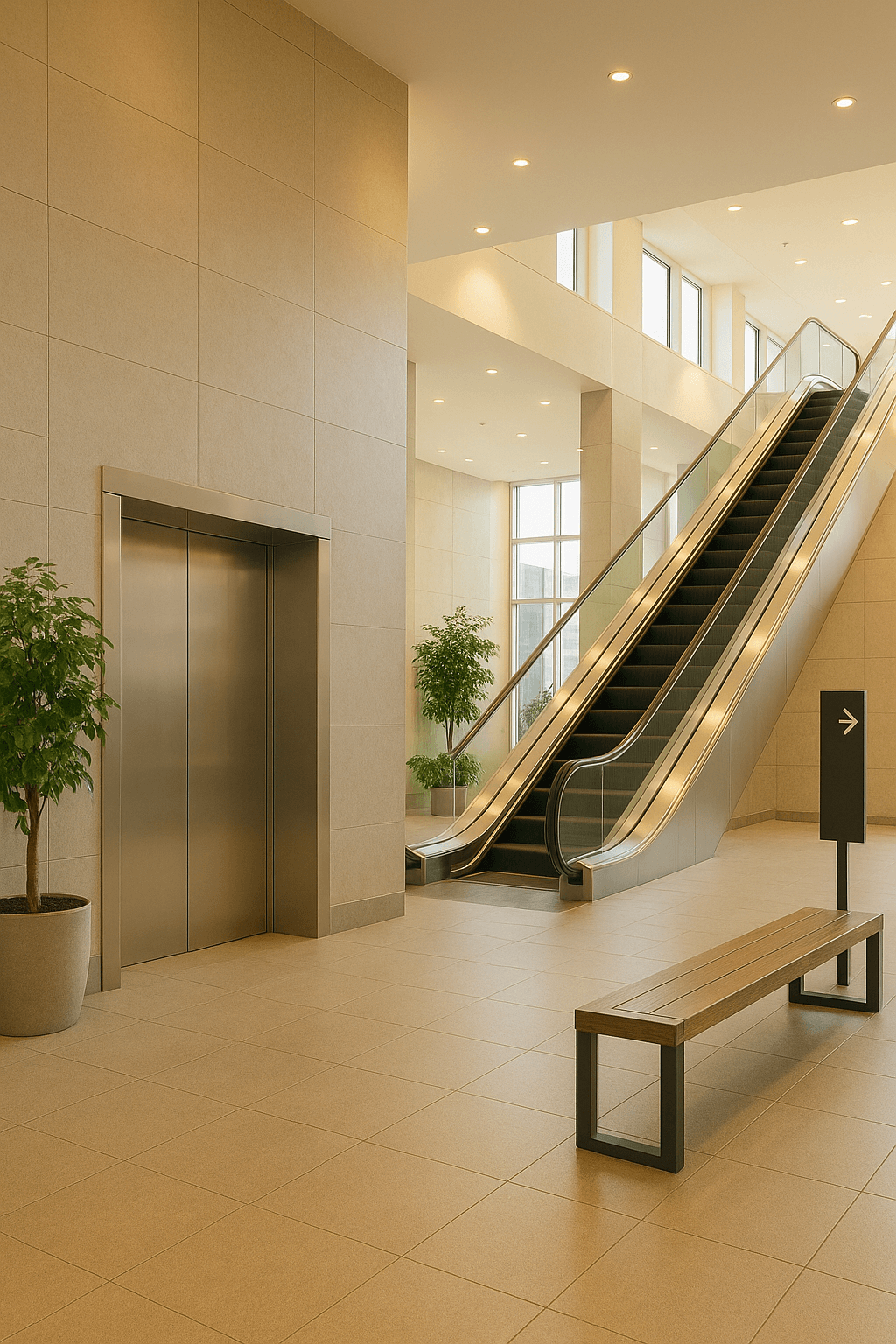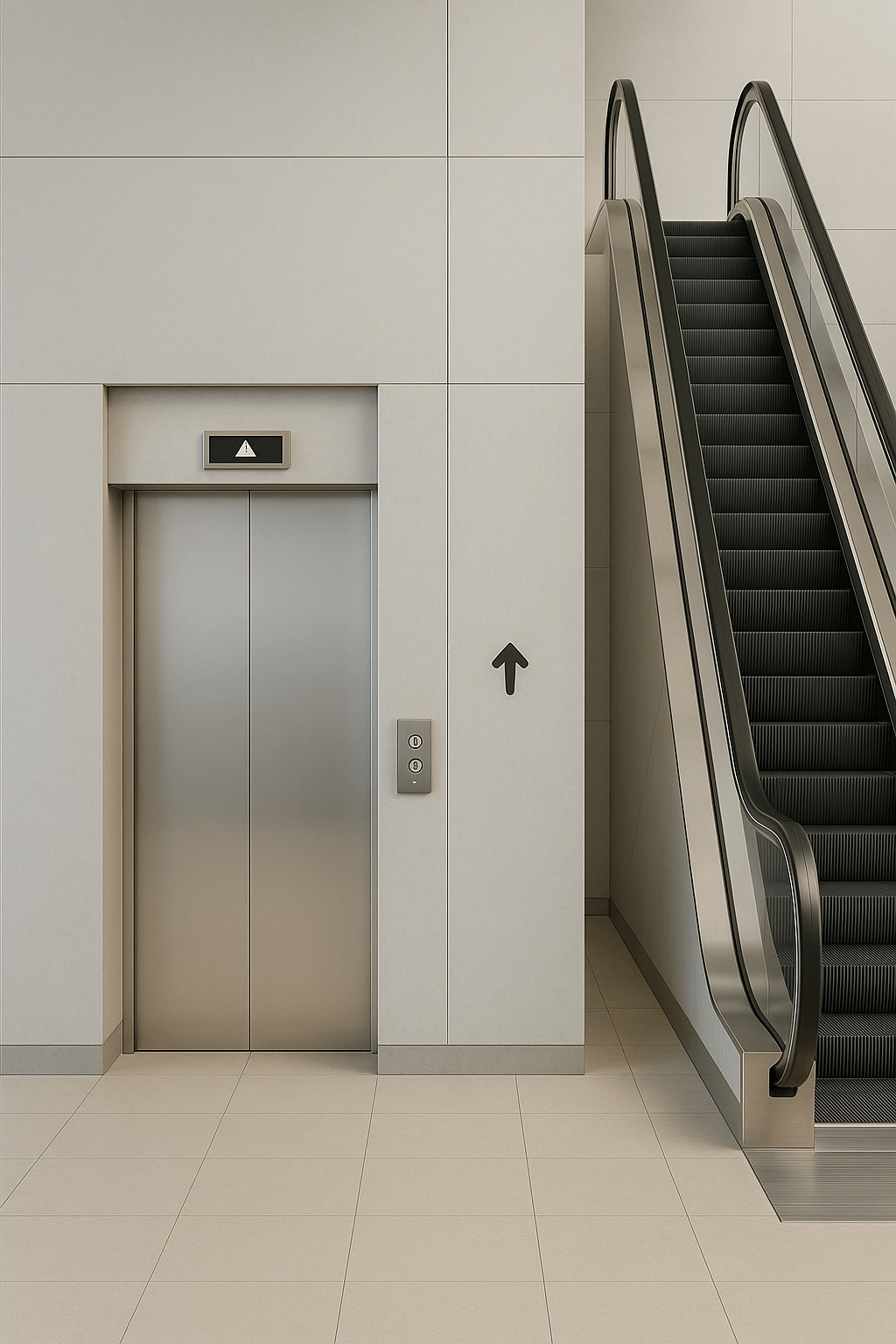Customs Clearance of Elevators, Escalators & Stairlifts in Iran (HS Code + Documents & Permits)
For an estimate of time and cost for clearing elevators, escalators, and stairlifts, contact the Saba Tarkhis experts.
Instant free consultation
1) Customs Clearance of Elevators
Applications of elevators:
Productivity gains: By reducing travel time and easing movement between floors, elevators help improve efficiency in high-traffic environments.
Enhanced safety: Especially in emergencies such as fires, elevators with advanced safety systems play an important role in fast and safe evacuation.
Key considerations in elevator clearance:
Technical documentation and engineering drawings: Submitting technical documents, including precise engineering drawings, equipment specifications, and installation/operation manuals, is mandatory to obtain clearance permits.
Pre-clearance inspections: ISIRI (National Standards Organization of Iran) and/or other regulators may conduct detailed inspections before clearance to ensure compliance with required standards.
Elevator customs tariff:
The customs tariff (HS Code) for elevators is 842810. This code is used to classify imported elevators in the Harmonized System and determines duties and customs requirements.
2) Customs Clearance of Escalators
Applications of escalators:
Improved access and efficiency: By increasing travel speed, these devices enable quick access to different floors and thus improve productivity in crowded environments.
Key considerations in escalator clearance:
Technical and safety inspection: Before clearance, escalators undergo technical inspections to ensure all safety requirements are met, including anti-slip systems, proper motor operation, and emergency systems.
Escalator customs tariff:
The customs tariff (HS Code) for escalators is 842840. This code determines customs duties and import requirements for escalators.
Special conditions for importing escalators:
Obtaining essential permits: Escalator imports require permits from the Ministry of Industry, Mine and Trade (MIMT) and safety/standards approvals from ISIRI.
International certifications: Valid safety and performance certifications from global authorities such as ISO and CE must be provided to confirm the quality and safety of imported equipment.
3) Customs Clearance of Stairlifts
Applications of stairlifts:
Facilitating movement between floors: Especially for those unable to use stairs, stairlifts provide a safe and efficient solution for moving between levels.
Key considerations in stairlift clearance:
Technical documents and safety certificates: To obtain clearance, technical documents including specifications, safety certificates, and performance approvals from international authorities such as the FDA or CE are required.
Stairlift customs tariff:
The customs tariff (HS Code) for stairlifts is 842890. This code is used for classification, duty calculation, and other customs requirements related to stairlifts.
Special conditions for importing stairlifts:
Permit from the Ministry of Health: Importing medical and assistive equipment, including stairlifts, requires permits from the Ministry of Health and Medical Education.
Quality and safety certifications: International certifications from reputable bodies such as CE (Conformité Européenne) and FDA (Food and Drug Administration) are essential to validate quality and safety.
4) Import & Export
Elevators: Elevators are mainly imported from advanced industrial countries such as Germany, China, Japan, and South Korea. Due to advanced technologies in elevator manufacturing and adherence to high safety and quality standards, these countries are the primary suppliers for the Iranian market.
Escalators: Escalators are predominantly imported from countries like China, Japan, Germany, and South Korea. Owing to mass production and advanced technology, these countries are the main suppliers of escalators.
Stairlifts: Stairlifts, which are mostly used as medical and accessibility equipment, are mainly imported from the United States, Japan, and Germany. Given their high safety and quality standards, these countries are the primary suppliers.
Exports from Iran:
Elevators: Elevator exports from Iran go to neighboring and regional countries such as Iraq, Afghanistan, Armenia, and Azerbaijan. With technical know-how and capabilities in assembly and partial component production, Iran can meet part of these countries’ needs.
Escalators: Due to technical complexity and reliance on imported parts, escalator exports from Iran are less common, though limited exports occur to neighboring countries like Iraq and Afghanistan.
Stairlifts: Exports of stairlifts from Iran to regional countries such as Iraq and Afghanistan are limited and mainly occur within specific projects or as part of medical equipment packages.
Overall, these devices are largely imported into Iran from industrialized countries, while exports are mainly limited to neighboring and regional markets.
5) Global Market Size
The global elevator and escalator industry is very large. According to international estimates, the global market in 2023 exceeded USD 100 billion. Major global companies like Otis, KONE, Schindler, and ThyssenKrupp hold significant market shares. Annual growth, driven by urbanization and infrastructure development in emerging countries, is forecast at roughly 5–7%.
Stairlifts:
The global stairlift market is much smaller than elevators/escalators but is growing due to rising demand for medical and assistive equipment, especially in developed countries. The 2023 market size is estimated at around USD 2–3 billion, with expected annual growth of 4–6% as aging societies expand needs.
6) Common HS Codes Table
| Goods | Short Description | HS Code |
|---|---|---|
| Elevator | Electric/hydraulic building lifts | 842810 |
| Escalator | Mechanical step conveyor | 842840 |
| Stairlift | Other lifts/conveyors | 842890 |
Final classification depends on model, installation method, power source, accompanying components, medical/general use, and manufacturer documentation.
Need precise HS Code determination, permits, and document preparation? Our team manages your case end-to-end.
Submit a proforma request
Frequently Asked Questions
What are the HS Codes for elevators, escalators, and stairlifts?
Per the text: elevator 842810, escalator 842840, and stairlift 842890; final determination depends on technical specifications.
Which standards are mandatory for clearance?
For elevators: EN 81 / ISO 25745 and national standard 6303-1; for escalators: EN 115 / ASME A17.1; and for stairlifts: ISO 7176 / IEC 60601, as noted in the text.
What permits are required for import?
For elevators and escalators: permits from the Ministry of Industry, Mine and Trade and ISIRI approvals; for stairlifts: Ministry of Health permits plus CE/UL/FDA certificates, as stated.
Special Customs Clearance Services by Saba Brokerage
One of the most reputable customs companies in Iran provides comprehensive, specialized services for clearing various industrial and medical equipment, including elevators, escalators, and stairlifts. The company’s skilled and experienced team, fully versed in customs laws and regulations and with extensive experience in clearing complex and sensitive goods, is ready to offer specialized services to importers.
These services include:
Specialized consulting on customs clearance: Providing accurate, expert advice on customs regulations, tariffs, and import standards.
High-speed, precise customs processing: The clearance process is carried out with maximum speed and accuracy by a highly experienced, knowledgeable team.
Inspection and quality control services: Pre-clearance inspections are performed to ensure goods comply with required standards.
Administrative follow-up and obtaining permits: All administrative procedures for obtaining necessary permits and certificates are pursued diligently and professionally.
Secure transport and warehousing: Safe logistics and storage services are provided for sensitive and high-value equipment.
By choosing this company, importers can benefit from professional, fast, and reliable services and complete their clearance process without worry. With a comprehensive and meticulous approach, the company covers all importer needs throughout the clearance process and ensures success at every stage.
.png)
